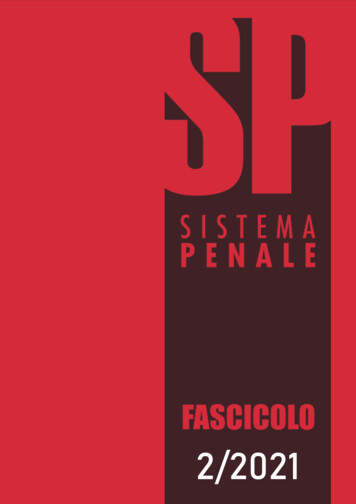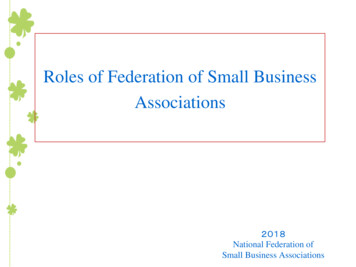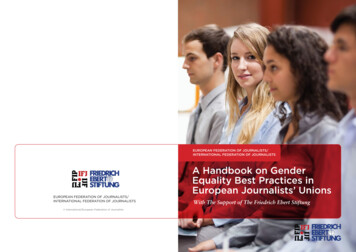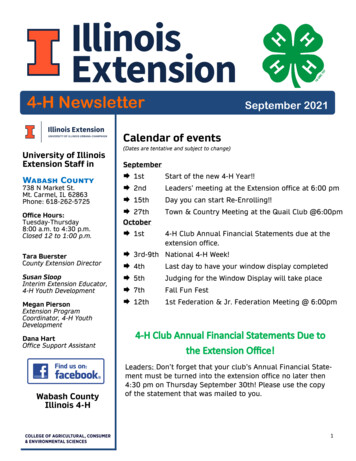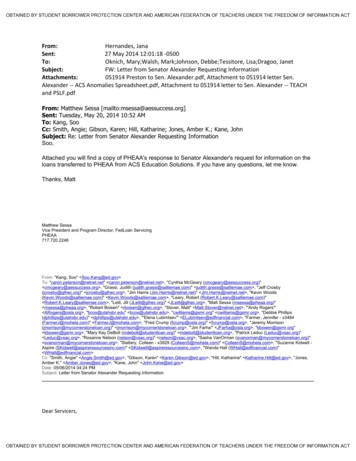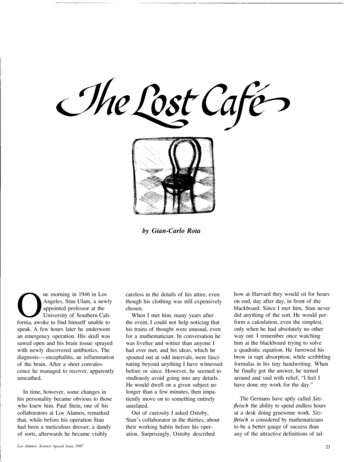
Transcription
by Gian-Carlo Rotaone morning in 1946 in LosAngeles, Stan Ulam, a newlyappointed professor at theUniversity of Southern California, awoke to find himself unable tospeak. A few hours later he underwentan emergency operation. His skull wassawed open and his brain tissue sprayedwith newly discovered antibiotics. Thediagnosis----encephalitis, an inflammationof the brain. After a short convalescence he managed to recover, apparentlyunscathed.In time, however, some changes inhis personality became obvious to thosewho knew him. Paul Stein, one of hiscollaborators at Los Alamos, remarkedthat, while before his operation Stanhad been a meticulous dresser, a dandyof sorts, afterwards he became visiblyLos Alumos Science Special Issue 1987careless in the details of his attire, eventhough his clothing was still expensivelychosen.When I met him, many years afterthe event, I could not help noticing thathis trains of thought were unusual, evenfor a mathematician. In conversation hewas livelier and wittier than anyone Ihad ever met, and his ideas, which hespouted out at odd intervals, were fascinating beyond anything I have witnessedbefore or since. However, he seemed tostudiously avoid going into any details.He would dwell on a given subject nolonger than a few minutes, then impatiently move on to something entirelyunrelated.Out of curiosity I asked Oxtoby,Stan’s collaborator in the thirties, abouttheir working habits before his operation. Surprisingly, Oxtoby describedhow at Harvard they would sit for hourson end, day after day, in front of theblackboard. Since I met him, Stan neverdid anything of the sort. He would perform a calculation, even the simplest,only when he had absolutely no otherway out. I remember once watchinghim at the blackboard trying to solvea quadratic equation. He furrowed hisbrow in rapt absorption, while scribblingformulas in his tiny handwriting. Whenhe finally got the answer, he turnedaround and said with relief, “I feel Ihave done my work for the day.”The Germans have aptly called Sz7zjleisch the ability to spend endless hoursat a desk doing gruesome work. Sitzjlezkch is considered by mathematiciansto be a better gauge of success thanany of the attractive definitions of tal23
ent with which psychologists regale usfrom time to time. Stan Ulam was ableto get by without any Sitzjeisch whatsoever. After his bout with encephalitis, he came to lean instead on his ownunimpaired imagination for new ideasand on the Sitzjeisch of others for technical support. The beauty of his insightsand the promise of his proposals kepthim amply supplied with young collaborators always willing to lend (andsometimes risking to waste) their time.A crippling technical weakness coupled with an extraordinarily creativeimagination is the drama of Stan Ulam.Soon after I met him, I was made to understand that, as far as our conversationswent, his drama would be a ForbiddenTopic. Perhaps he discussed it with hisdaughter, Claire, the only person withwhom he would occasionally have brutally frank discussions, but certainly notwith anyone else. But he knew I knew,and I knew he knew I knew.stan Ulam was born into a familythat stood as high on the socialladder as a Jewish family could atthe time. He was the golden boy fromone of the richest families of Lwow.In central Europe the Ulam name wasthen a synonym of banking wealth, notunlike the Rothschilds’ in westem Europe. He was educated by private tutorsand in the best schools. As a child healready showed an unusual interest inastronomy (’’I am star-struck,” he wouldoften tell me) and in physics. At theage of twelve he was reasonably familiar with the outlines of the specialtheory of relativity, a great novelty atthe time. In high school he was a topstudent, far too bright for his age. Hisquick wit got him good grades with little effort but lent free rein to his laziness.The two authors he read thoroughlyin his teens were Karl May and AnatoleFrance. They had a formative influ24ence on his personality, and throughout his life he kept going back to themfor comfort. From Karl May’s numerous adventure novels (popular enoughin the German-speaking world to beamong the favorite books of both Einstein and Hitler) he derived the childlikeand ever fresh feeling of wonder that isoften found in great men. From AnatoleFrance he took his man-of-the-worldmannerisms, which in later life wouldendear him to young ladies.He kept a complete set of Karl May’snovels (in German, the other languageof his childhood) behind his desk until he died. He regretted that a Pfiiadeedition of Anatole France had not beenpublished, which he could keep by hisbedside. He often gave me paperbacksof Anatole France, bought on his frequent trips to Paris and dedicated withinscriptions urging me to read them. Iregret to admit I haven’t.There was never any doubt that hewould study mathematics when, at ageseventeen, he enrolled at Lwow Polytechnic Institute. Shortly after classesstarted he discovered with relief thatthe mathematics that really matteredwas not taught in the classroom, butwas instead to be found alive in oneof the large caf& in town, the Scottish Caft5. There the Lwow mathematicians would congregate daily. Betweena shot of brandy and a cup of coffee,they would pose (and often solve) whatturned out to be some of the outstanding mathematical conjectures of theirtime, conjectures that would be dashedoff on the marble of coffee tables in thelate evenings, in loud and uninhibitedbrawls.The Lw6w school was made up ofoffbeat, undisciplined types. Stan’steacher Banach was an alcoholic, andhis best friend Mazur was a Communist.They cultivated the new fields of measure theory, set theory, and functionalanalysis, which at the time requiredvery little background. The rival Warsaw mathematicians, more conservative,looked down on the Lw6w mathematicians as amateurish upstarts, but theresults of the Lwow school soon cameto be better known and appreciated theworld over, largely after the publicationof Banach’s book on linear operators,in which Ulam’s name is the most frequently mentioned.One day the amateur Ulam went oneup on the Warsaw mathematicians, whocultivated the equally new field of algebraic topology. While chatting atthe Scottish Caf6 with Borsuk, an outstanding Warsaw topologist, he saw in aflash the truth of what is now called theBorsuk-Ulam theorem. Borsuk had tocommandeer all his technical resourcesto prove it. News of the result quicklyswept across the ocean, and Ulam became an instant topologist.Stan took to cafd-mathematics like afish to water. He quickly became themost daring of the Lwow mathematicians in formulating bold new mathematical conjectures. Almost all hisguesses of that time have been provedtrue and are now to be found as theorems scattered in graduate textbooks.In the casual ambiance of the Scottish Caf6, Stan blossomed into one ofthe most promising mathematicians ofhis generation. He also began to display the contradictory traits in behaviorthat after his operation were to becomedominant: deep intuition and impatiencewith detail, playful inventiveness anddislike of prolonged work. He began toLos Alumor .Rieni( Speed Issue [987
view mathematics as a game, one thata well-bred gentleman should not taketoo seriously. His insights have openedwhole new areas of mathematics, all ofthem still actively cultivated today, buthe himself could not bear to give hisdiscoveries more than a passing interest,and at times he would make mercilessfun of those who did take them too seriously.1The papers in mathematics that hewrote by himself date back to this period. Most were written in one sitting,often in a night’s work, probably in response to some colleague’s challenge atthe Scottish Caf&. Much of his presentreputation as a mathematician rests onthese short, brilliant notes. His measurable cardinals, the best idea he had inthis period, are still the mainspring ofmuch present work in set theory. Moreoften, however, his flashes of originality, scattered as they are in unexpectedcontexts, have been appropriated by others with little acknowledgement, andhave proved decisive in making morethan one career in mathematics. For example, his paper with Lomnicki on thefoundations of probability, which alsodates back to his Polish period, contains a casual remark on the existence ofprime ideals in Boolean algebras, laterdeveloped by Tarski and others in several formidable papers.The Borsuk-Ulam theorem was striking enough to catch the attention ofSolomon Lefschetz, the leading topologist of the time and the chairman ofthe Princeton mathematics department.Through Lefschetz and von Neumann,with whom he had started to correspond, Ulam was invited in 1936 tovisit the Institute for Advanced Studyin Princeton.For four years he commuted betweenPoland and America where, first inPrinceton and later at the Harvard Society of Fellows, he lived in luxury on hisparents’ monthly checks. In the sumLos Alumo. .Y wn[e Special Issue1987mer of 1939, shortly after he returned tothe United States with his brother fromwhat would be the last visit to his family, World War II broke out. By accident he had been saved from almost certain extinction. He would never leavethe United States again, except on shorttrips.he belle kpoque, the period thatruns between 1870 and the 1930s(though some claim that it endedwith World War I), was one of the happiest times of our civilization. Vienna,Prague, Lw6w, and Budapest were capitals of turn-of-the-century sophistication,though they lacked the staid traditionsof Paris. Florence, or Aranjuez. RobertMusil, Gustav Mahler, Franz Kafka,Ludwig Wittgenstein, and the philosophers of the Vienna Circle have becomefor us symbols of mitteleuropaische Kultur. Most of those now legendary figures betrayed personality traits similarto Stan’s: restlessness, intolerance, adialectic of arrogance and contrition,and an unsatisfied need for affection,compounded by their society’s failure tosettle on a firm code for the expressionof emotion. Perhaps the roots of thetragedy that befell central Europe shouldbe looked for in those men’s tragic livesand flawed personalities. rather thanin the scurrilous outbursts of some demented housepainter.When the catastrophe came, thoseamong them who were still alive towatch their world go up in flames neverrecovered from the shock. They re-Tmained emotionally crippled for the restof their lives.Stan Ulam was one of them. Had hebeen able to remain in Poland and survive the war, as Steinhaus, Kuratowski,and a few others did, he would havegone on to become one of the leadinginternational figures of pure mathematics, at least on a par with Banach. Butafter he bade farewell to his friends atthe Scottish Caf6, something died forever within him, and his career as apure mathematician went permanentlyadrift.Like other immigrants from the European leisure class, Stan arrived in theUnited States ill-equipped for the rigorsof puritan society.The big open spaces of America, thedemands for aloneness and self-reliancemade him feel estranged. He wishedto belong, and he loved this country,but he never came to feel fully at homein the United States, whether in Cambridge, Madison, or Los Alamos. Hemissed the lively street life of Europeancities, the culture, the rambling conversations (what the Spanish call tertulias)and viewed with alarm the decay of thatart, which in our day has become all butextinct.By now the effective American wayof scientific exchange has imposed itself on the rest of the world. But fiftyyears ago life in American universities was incomparably duller than thecaf6-science of Lwow. The atmosphereof Cambridge in the thirties was toocold, and, what was worse, there wereno caf&. And then, in Europe, the warstarted.In the fall of 1939, Stan would spendendless hours watching the CharlesRiver from his room at Harvard, stupefied by the sudden turn of eventsthat had changed his life and that of somany others. He learned of the fall ofPoland, of the deportation of his family25
to a concentration camp (his sister anduncles were killed in gas chambers), ofthe sacking of the great Ulam bank.He was all alone now. His father’smonthly checks had stopped, his JuniorFellowship would soon run out, and hewould have to support his brother’s college education at Brown. He pinnedgreat hopes on his big paper on ergodic theory, which he had just finishedwriting with Oxtoby and which hadbeen accepted for publication in Annulsof Mathemati(.s, the most prestigiousmathematics journal. In the solitude ofAdams House, he could not bring himself to finish a paper by himself, thoughhis lectures on the theory of functionsof several real variables were the mostbrilliant he ever delivered (some formerstudents still cherish the notes they tookof that course).G. D. Birkhoff, the ranking Harvardmathematician and the absolute monarchof American mathematics, took a liking to Stan Ulam. Like other personsrumored to be anti-Semitic, he wouldoccasionally feel the urge to showerhis protective instincts on some good-looking young Jew. Ulam’s sparklingmanners were diametrically oppositeto Birkhoff’s hind-working, aggressive, touchy personality. Birkhoff triedto keep Ulam at Harvard, but his colleagues balked at the idea. After all,Ulam had only one long paper in courseof publication, and it can be surmisedthat the Harvard mathematicians of thethirties turned up their noses at the abstract lucubrations of a student of Banach.Birkhoff then began to write letters tohis friends at several universities, suggesting Ulam’s name for appointment.It didn’t take long before Stan receivedan offer from the University of Wisconsin in Madison, an assistant professorship carrying a rather high stipend forthe time, over two thousand dollars. Hehad no choice but to accept it.For the first time in his life, Stan had26to do “an honest day’s work,” and hedidn’t like the thought. The teachingload of some twelve hours a week ofpre-calculus soon turned into a torture.Rumor had it that he had occasionallyfallen asleep while lecturing. Madison, a friendly little Midwestern town,was the end of the world for a worldlyyoung European. The ambiance wasmore non-existent than dismal. Hiscolleagues, upright men and worldrenowned mathematicians like Everettand Kleene, were not the garrulousSlavic types he was used to. Then after Stan’s second year at Wisconsin,America entered the war.Once more John von Neumann cameto Stan’s rescue.of all escapes from reality, mathematics is the most successful ever. It is a fantasy thatbecomes all the more addictive because it works back to improve thesame reality we are trying to evade.All other escapes—love, drugs, hobbies, whatever—are ephemeral by comparison. The mathematician’s feelingof triumph, as he forces the world toobey the laws his imagination has freelycreated, feeds on its own success. Theworld is permanently changed by theworkings of his mind, and the certaintythat his creations will endure renewshis confidence as no other pursuit. Themathematician becomes totally committed, a monster like Nabokov’s chessplayer, who eventually sees all life assubordinate to the game of chess.Many of us remember the feelingof ecstasy we experienced when wefirst read von Neumann’s series of papers on rings of operators in Hilbertspace. It is a paradise from which noone will ever dislodge us (as Hilbertsaid of Cantor’s set theory). But vonNeumann’s achievements went far beyond the reaches of pure mathematics.Together with Ulam he was the first tohave a vision of the boundless possibilities of computing, and he had theresolve to gather the considerable intellectual and engineering resources thatled to the construction of the first computer. No other mathematician of thiscentury has had as deep and lasting aninfluence on the course of civilization.Von Neumann was a lonely man withdeep personal problems. He had twodifficult marriages. He had trouble relating to others except on a strictly impersonal level. Whoever spoke to himnoticed a certain aloofness, a distancethat would never be bridged. He wasalways formally dressed in impeccablebusiness suits, and he always kept hisjacket on (even on horseback), as if toshield himself from the world.Stan was probably the only closefriend von Neumann ever had. A similar background and a common cultureshock brought them together. Theywould spend hours on end gossipingand giggling, swapping Jewish jokes,and drifting in and out of mathematicaltalk.Stan was the more original mathematician of the two, though he accomplished far less in mathematics than vonNeumann did. Von Neumann had an incomparably stronger technique. Fromtheir free play of ideas came some ofthe great advances in applied mathematics of our day: the Monte Carlomethod, mathematical experiments onthe computer, cellular automata, simulated growth patterns.Like everyone who works with abstractions, von Neumann needed constant reassurance against deep-seatedL[H A[um[]3 S(ienc Speed Issue1987
and recuming self-doubts. Followinghis uncanny instinct for doing the rightthing at the right time, Stan soon foundthe way to cheer up his brooding friend.He began to make fun of von Neumann’s accomplishments. He wouldmercilessly ridicule continuous geometries, Hilbert space, and rings of operators, cleverly picking on weaknesses invon Neumann’s work that were obviousand expected. Stan’s jibes were an indirect but firm expression of admiration.Rather than feel offended, von Neumannwould burst out in a laughter of relief.Much later, when Stan related to methese events, he affected to regret neverhaving said a kind word to von Neumann about his work in pure mathematics. But I could feel he was not serious.Deep inside he knew he had been goodto his friend.Stan didn’t fully realize how muchvon Neumann meant to him until hisfriend began to die of cancer, in 1955.Stan would make frequent trips to Walter Reed Hospital in Washington, wherefor months on end his honored friendwas confined to a bed in the PresidentialSuite. Stan came prepared with a bagful of the latest jokes and prurient LosAlamos gossip. The little hospital bedwould shake with the vibrations of vonNeumann’s big belly as he laughed himself to tears, the very tears that Stan wasfighting to control. Then weeks passedwhen von Neumann could no longerrecognize anyone. When he finally died,Stan broke into tears. It was probahlythe only time in his life when he openlylost control of his emotions.ack in 1941 shortly after theUnited States entered the war,Stan (then still at Wisconsin)began to notice that von Neumann’s letters were becoming infrequent. Curiousabout his friend’s mysterious unavailability, Stan managed one day to corner him in Chicago. He implored vonBLIM Alum(]s .hare Special 15sue 1!287Neumann to drag him out of his Wisconsin rut and to get him a job relatedto the war effort. The request fit perfectly with von Neumann’s plans. Hehad already made up his mind to bringStan with him to the newly founded LosAlamos laboratory, where the atomicbomb project was being launched.The choice of a set theorist for workin applied physics might seem eccentric, but in retrospect von Neumannmade the right choice. Besides, as thetoken mathematician in a sea of physicists (though he was probably one of thefinest minds among them, together withFermi and Feynman), von Neumann wasrelieved to have his cohort join him.The assembly of geniuses who roamedthe corridors of the Los Alamos laboratory during World War II has not beenmatched in recorded history, with thepossible exception of ancient Greece. Inthe hothouse of the Manhattan Project,Stan’s mind opened up as it hadn’t sincethe days of the Scottish Caft5. The jointefforts of the best scientists of the time,their talents stimulated and strained bythe challenge of a difficult project, madewhat could have been a drab weaponslaboratory into a cradle of new ideas.In welcome breaks between long stintsat the bench, in a comer at some louddrinking party, the postwar revolutionsin science were being hatched.Los Alamos was a turning point inStan Ulam’s career. From that time onphysics, not mathematics, became thecenter of his interest. After watchingFermi and Feynman at the blackboard,he discovered that he too had a knackfor accurately estimating physical quantities by doing simple calculations withorders of magnitude. In fact. he turnedout to be better at that game than justabout anyone around him.It is hard to overstate how rare suchan ability is in a mathematician. Theliteralness of mathematics is as far removed from the practical needs of thephysicist as might be the story of theWizard of Oz. As Stan began to display his newly found talent, he cameto rely less and less on standard mathematical techniques and to view ordinary mathematics with some contempt.He admired Fermi’s genius for solvingphysical problems with no more thanthe minimum amount of math. Sincethat time Fermi remained for him theideal of a scientist. In his old age heliked to repeat (perhaps with a touch ofexaggeration) that Fermi had been thelast physicist.But the Magic Mountain lasted onlyas long as the war. In 1945 it seemedthat the Los Alamos laboratory mightclose down, like many other wartimeprojects, and Stan began to look for ajob elsewhere. Unfofiunately, his list ofpublications was hardly longer now thanit had been in 1939, and unpublishedwork gets no credit. To his chagrin hewas ignored by the major universities.He finally had to accept the offer of aprofessorship at the University of Southern California, at the time a second-rateinstitution but one with great plans forthe future.Suddenly he found himself in themiddle of an asphalt jungle, teachingcalculus to morons. The memories ofhis friends in Los Alamos, of the endless discussions, of the all-night pokergames, haunted him as he commuteddaily among the tawdry streets of LosAngeles. The golden boy had lost thecompany of great minds, his audienceof admirers. Like anguish that could nolonger be contained, encephalitis struck.We still tend to regard disease as amere physical occurrence, as an unfore27
seen impairment of the body that also,mysteriously, affects the mind. But thisis an oversimplification. After a man’sdeath, at the time of the final reckoning,an event that might once have appearedaccidental is viewed as inevitable. StanUlam’s attack of encephalitis was theculmination of his despair.After recovering from his operation,Stan resigned his position in a hurry andwent back to Los Alamos.he year was 1946, and the LosAlamos laboratory was now a different place. Gone were most ofthe luminaries (though many of themwould make cameo appearances as consultants), and the federal governmentwas lavishing limitless funds on the laboratory. For a few years Los Alamosscientists found themselves coddled, secure and able to do or not do whateverthey pleased, free to roam around theworld in red-carpeted MATS flights (thatis, until Americans decided to give upthe Empire they had won).Ulam came back to Los Alamoshaunted by the fear that his illness mighthave irreparably damaged his brain. Heknew his way of thinking had neverbeen that of an ordinary mathematician, and now less than ever. He alsofeared that whatever was left of his talents might quickly fade. He decided thetime had come to engage in some substantial project that would be a fair testof his abilities, and one with which hisname might perhaps remain associated.While at Wisconsin, Stan had met Everett. They had jointly written the firstpaper on the subject tbat is now calledalgebraic logic (a beautiful paper thathas been plundered without acknowledgement). Everett, a seclusive and taciturn man, was richly endowed with theability to compute. He was a good listener, and he suffered from a paranoidfear of being fired for wasting Lab timeon research in pure mathematics. HeT28was a perfect complement to Stan. After he had accepted Stan’s invitation tocome to Los Alamos, they joined forceson a long and successful collaboration.As their first project they chose thetbeory of branching processes. Theybelieved they were the first to discoverthe probabilistic interpretation of functional composition. (They had ignoredall previous work, all the way back toGalton and Watson in the nineteenthcentury! Stan never had the patience toleaf through published research papers.He hated to learn from others what hethought he could invent by himself andoften did). They rediscovered all thathad been already done, and added atleast as much of their own. Tbeir results were drafted by Everett in threelengthy lab reports, which found substantial applications in the theory ofneutron diffusion, an essential step inthe understanding of nuclear reactions.These reports were never published,but they nevertheless had a decisive influence on the development of what isstill a thriving branch of probability theory. The authors have received littleacknowledgement for their work, perhaps as a spiteful punishment for theirown neglect of the work of others.Their second project was the bydrogen bomb.stan Ulam and Edward Teller haddisliked each other from the moment they had met. Since thedays of the Manhattan Project, Tellerhad been somewhat of a loner. His be-havior put him outside the main-lineBethe-Fermi-Oppenheimer group, andnot even his fellow Hungarian von Neumann felt at ease with him. This despitethe fact that he distinguished himselffrom the first days of Los Alamos asone of the most brilliant applied physicists there.Teller related with difficulty anddiffidence to other scientists of his age.He felt more at ease either with youngpeople or with celebrities, highly placedpoliticians, generals and admirals. Hisgroup (what eventually became theLawrence Livermore Laboratory after he left Los Alamos in a huffl washighly disciplined, rank-conscious, andloyal. He would sagely guide his students and assistants to doing the bestresearch work they were capable of,and he would reward his followers withtop-rank positions in academic administration or in government.Since the success of the first bomb,Teller had been obsessed by the ideaof the “Super.” Because of disagreements between bim and Oppenheimer,his project had more than once been onthe verge of being cancelled. Now, StanUlam was out to get him by provingthat his plans for the new bomb wouldnot work.For about two years Everett and Ulamworked frantically in competition withTeller’s group. They met every rooming for several hours in a little officeout of the way. Ulam would generatean endless stream of ideas and guesses,and Everett would check eacb one ofthem with feverish computations. Ina few months’ time Everett wore outseveral slide rules. At last they provedTeller wrong. And then, adding insultto injury, Stan, in a sudden flash of inspiration, came upon a trick to make thefirst hydrogen weapon work.The full extent of Stan’s contributionto the design of the first hydrogen bombwill never be precisely established. It isL[M Alum ). S[leme Speed Issue1987
certain, however, that he was instrumental in demolishing misguided proposalsthat would have resulted in considerable waste of time and funds. It is alibut certain that the seed idea that finallyworked was his own. At any rate, theensuing loud dispute with Teller overthe priority of the invention brought himwide publicity. (The patent applicationfor the device was jointly submitted byTeller and Ulam.) The Democrats soonsaw their advantage in adopting Ulam asa bulwark against the Republicans, whohad Teller on their side. He was invitedto sit in on important Washington committees and later became a darling ofthe Kennedy era.At last some of the glitter of his Polish youth had come back, if not in theform of tangible wealth, at least in theguise of public recognition.he late forties and fifties w’ere thehigh point of Stan Ulam’s life.His personality thrived. His conversation, always lively, became all themore witty and engaging. The betterpart of his day was spent telling jokesand funny stories and inventing oneinteresting mathematical idea after another, like a wheel of fortune that neverstopped. The joke was the literary formhe most appreciated. He would comeup with anecdotes, ideas, and stories onany subject of his acquaintance, however little his competence. He so likedto dominate a conversation that someof his colleagues began to take pains toavoid him. Now he had to win everyargument. When he felt he was on thelosing side, he would abruptly changethe subject, but not before seeing thebottom of the other person’s positionand summarizing it with irritating accuracy. Considering how fast it all happened, it is remarkable how seldom hemisunderstood. Mathematicians felt putdown, and Ulam’s ways alienated himfrom the guild. He retaliated by claim-T[.1)s A/am[)s S( it’n( e Special f\\ue /987ing not to be a “professional” mathematician and by going into ramblingtirades against the myopia of much contemporary mathematics.The free rein Ulam gave to his fantasy fed on one of his latent weaknesses—his wishful thinking. He became anartist at self-deception. He would goto great lengths to avoid facing the unpleasant realities of daily life. Whenanyone close to him became ill, hewould seize on every straw to pretendthat nothing was really wrong. Whenabsolutely forced to face an unpleasantfact, he would drop into a chair and fallinto a silent and wide-eyed panic.His severest critics were those closeto him who felt excluded from his private world, who stood outside the mightyfortress of mathematics. His daughter would browbeat him and cut himto pieces at regular intervals, incredulous of her father’s achievements. Hetook her criticisms in silence, and wasfond of quoting one of James Thurber’slovely generalizations: “Generals areafraid of their daughters.”Despite the comfort of the Los AlamosLaboratory (in the fifties and sixtiesUlam was one of two research advisorsto the Director of the laboratory), Stancould find no peace there. Since his ret
Poland and America where, first in Princeton and later at the Harvard Soci-ety of Fellows, he lived in luxury on his parents' monthly checks. In the sum-mer of 1939, shortly after he returned to the United States with his brother from what would be the last visit to his fam-ily, World War II broke out. By acci-dent he had been saved from .

